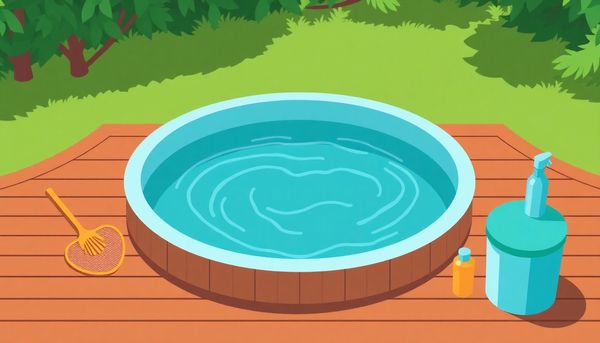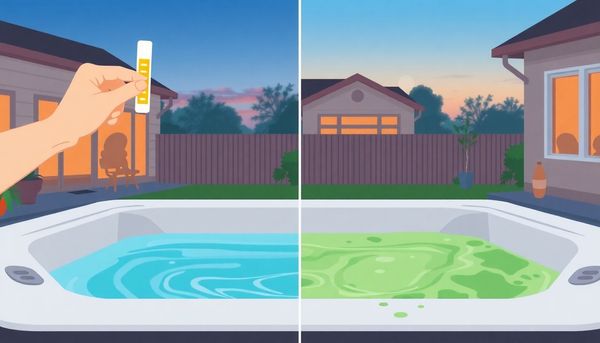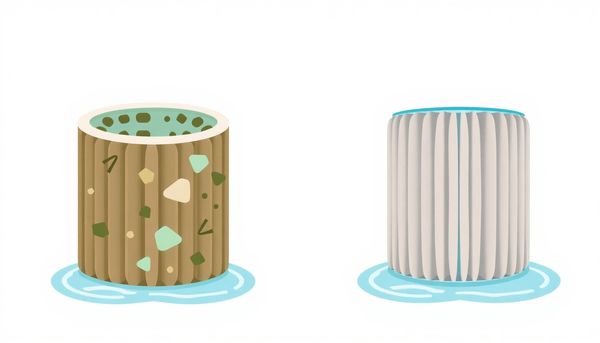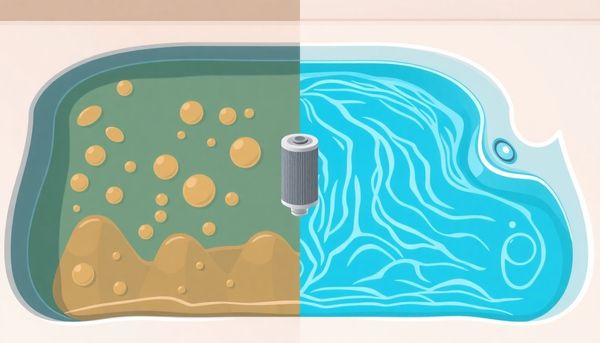Prevent Hot Tub Scum: Tips for a Pristine Soak
November 08th, 2024
November 08th, 2024
A hot tub is often seen as a sanctuary, a place where the day's stresses dissolve into the warm embrace of bubbling water. Yet, many hot tub owners are familiar with the unwelcome visitor known as hot tub scum. This unsightly buildup can appear seemingly overnight, transforming what should be a tranquil retreat into a maintenance challenge. But fear not; understanding the origins and prevention of this nuisance can restore your tub to its pristine glory.
Scum, the pesky residue that floats or clings to the sides of your tub, often results from a combination of body oils, lotions, and soaps. These substances mix with the minerals in your water, creating a stubborn film. You might have noticed after a lovely soak, the waterline bears a faint, greasy ring. This is the precursor to a more significant problem if left unattended.
Prevention is the key to maintaining a scum-free hot tub. Regular maintenance routines, such as balancing water chemistry and using scum-reducing products, can keep this issue at bay. An old friend once shared a tip: always shower before entering the tub. It sounded simple, almost too simple, yet it remarkably reduced the amount of residue left behind. Additionally, skimming the water surface and cleaning the filters regularly can work wonders in keeping your tub inviting and clear.
In the following sections, we'll delve into effective strategies to prevent and tackle this issue, ensuring your hot tub remains a haven of relaxation.

Stepping into a hot tub should be a luxurious escape, not a battle with unsightly scum. Yet, many find themselves contending with this unwelcome guest. It wasn't long ago that I faced a similar issue. One evening, after a long day, I sank into what I hoped would be an oasis of tranquility, only to find a greasy ring mocking me from the tub's edge.
The source of this scum often lies in an inconspicuous cocktail of personal care products, natural body oils, and metals present in water. Each time we soak, we're unknowingly contributing bits of ourselves—literally—to the hot tub environment. Shampoo residue, lotions, and natural oils do not simply evaporate; they cling to the water's surface, eventually forming that unsightly ring. My initial oversight was a lack of regular maintenance—a common pitfall for many.
To combat this, consistency is key. Regularly testing and balancing pH levels prevents mineral reactions that can exacerbate scum formation. Additionally, using a metal sequestrant can help manage metal content, thwarting those pesky greenish hues. Don't skip on rinsing off before a dip; it’s a small step that pays off. Lastly, replace filters before they become ineffective, ensuring they capture and remove contaminants efficiently. With these measures, hot tub scum becomes a thing of the past, leaving you free to enjoy your soak without interruption.
Hot tub scum is a bit like an uninvited guest who refuses to leave. Spotting a murky film on your soothing spa waters or a stubborn ring around the shell can put a damper on an anticipated soak. But understanding the villains behind this unwelcome intrusion is the first step in banishing them for good.
Our bodies, as it turns out, are significant contributors. Every day, we shed a multitude of dead skin cells and strands of hair, which find their way into your hot tub. Add to this the oils naturally produced by our skin, and it’s clear why the water might start resembling a soup of unwanted extras. Layer onto this the various personal care products—shampoos, lotions, and perfumes—and you've got a veritable cocktail of scum producers.
Beyond personal contributions, tap water can play a role. Depending on your location, the water you use might be rich in metals like copper and iron. These elements, when introduced to chlorine, can oxidize, leading to discolored scum floating on your spa’s surface. This isn't just a cosmetic issue; high metal content can also stain your hot tub’s shell.
Lastly, don’t overlook the importance of balanced water chemistry. If the pH levels are off, it creates the perfect breeding ground for bacteria and algae, escalating the scum situation. Each factor alone might not be a deal-breaker, but together, they can turn your hot tub into a haven for unsightly scum. Identifying these causes is crucial to maintaining a pristine and inviting retreat.
Balancing water in a hot tub isn’t merely about chemistry—it's the secret weapon against that unsightly scum. I remember the first time I saw a mysterious ring around my hot tub. It was a perplexing moment, where I thought, "How did this happen?" Then, I learned: keeping water balanced is crucial.
Firstly, understanding the role of pH is pivotal. High pH levels invite trouble, encouraging mineral build-up and bacterial growth, which love to lurk in those conditions. When I started testing my water regularly—weekly, without fail—I noticed a significant decrease in scum formation. Test strips became my best friends, offering immediate insights into pH levels.
Another tip I picked up was the importance of proper filtration. A clean filter doesn’t just purify the water; it’s your frontline defense against scum. I made it a habit to rinse my filter weekly and soak it in a cleaning solution monthly. This routine not only extended the filter’s lifespan but also kept my hot tub crystal clear.
Don’t underestimate the power of shock treatments, either. Shocking the water weekly, especially after heavy usage, zaps residual contaminants that might otherwise morph into scum. By maintaining these practices, not only did my hot tub stay scum-free, but it also provided a consistently inviting escape, free from the stress of an unwelcome grime invasion.
Filters are the unsung heroes of your hot tub—silent guardians that tirelessly work to keep water sparkling. Yet, like any diligent worker, they need regular attention. Think of your filter as the sponge of your spa, absorbing oils, dirt, and all those tiny particles you can’t see. Over time, this accumulation becomes too much for it to handle, leading to the dreaded scum.
Taking a proactive approach, it’s crucial to establish a routine for cleaning or replacing filters. A simple rinse under running water every week can do wonders. For a deeper clean, soaking the filter in a dedicated solution monthly helps dissolve those stubborn residues. Remember, even the most meticulous cleaning regimen can't stretch a filter's lifespan indefinitely; manufacturers typically recommend replacement every 12 to 18 months.
I learned this the hard way. A few summers back, my hot tub started developing a persistent ring despite my best efforts. It wasn’t until I swapped out the old filter for a fresh one that the water clarity returned, reminding me how crucial this component is. Don’t let a worn-out filter sabotage your relaxation time. By maintaining it properly, you ensure that your hot tub remains an inviting oasis, free from unwanted grime.
Staring into a hot tub only to find that the serene waters have been invaded by an unsightly layer of scum can be a real mood dampener. This stubborn invader often lurks in the form of an oily film or an unattractive ring along the shell. Let me tell you, having battled this issue in my own backyard oasis, I can assure you that there are effective ways to reclaim your pristine soak.
First, it's crucial to address the most apparent cause: a dirty filter. While my trusted filter managed to capture the usual suspects like dust and debris, it couldn’t handle the oils and lotions my family added with each dip. Cleaning the filter regularly with a garden hose and giving it a deep chemical soak every few months became a game-changer. When the filter started showing signs of wear, replacing it promptly saved me endless headaches.
In addition to maintaining the filter, a fine-mesh skimmer became my best friend. With regular skimming, those nasty surface oils didn’t stand a chance. I also discovered an unexpected hero in the form of oil-absorbing sponges. Tossing a couple of these into the water was like having a diligent helper silently soaking up the gunk.
Lastly, keeping the water's pH balanced was vital. Testing weekly with strips ensured I could adjust with a pH decreaser as needed, keeping minerals from reacting with the sanitizer. By following these steps, I managed to keep that pesky scum at bay and my hot tub an inviting retreat once more.
Contamination prevention in your hot tub begins long before you even step foot into the bubbly waters. Think about how everyday habits can silently sabotage the oasis you’ve worked hard to maintain. You wouldn’t wear muddy boots inside your home, right? It's the same principle with hot tubs. Before taking a dip, make it a ritual to rinse off any lotions, perfumes, and deodorants. A simple pre-soak shower can wash away much of the residue that clings to the body, from hair products to skin oils, which can otherwise end up clouding your water.
Consider the metals lurking in your water source. These invisible troublemakers, such as copper and iron, can react with chlorine and create unsightly scum. Using a hose filter when filling your tub can help reduce metal content. Additionally, keeping a metal sequestrant on hand can prevent these metals from reacting with chlorine, thus protecting your tub from unpleasant discoloration and deposits.
Even the most vigilant among us can overlook the power of proper water balance. Regularly test your water for pH and metal levels using test strips or liquid kits. Maintaining a balanced pH not only fights scum formation but also keeps algae and bacteria at bay. A commitment to these preventative measures goes a long way towards a pristine soaking experience, ensuring your hot tub remains a haven of relaxation, devoid of unwelcome intrusions.

Water chemistry in a hot tub is a bit of a balancing act, akin to juggling a mix of science and comfort. When you neglect this delicate equilibrium, the resulting chaos is an unwelcome guest: hot tub scum. The thin film on the water's surface or the crusty ring around the hot tub shell is not just unsightly—it's a telltale sign that your water's pH and alkalinity levels need attention.
Think of pH as the peacekeeper of your soak. If it's too high, it creates a perfect breeding ground for minerals and metals to react, leading to unsightly scum. I recall a time when my own hot tub turned into a chemistry experiment gone awry. The water had a murky hue, and a quick pH test revealed why—sky-high levels! A dose of pH decreaser later, and balance was restored.
Alkalinity acts as a buffer to the pH, warding off drastic fluctuations. Regularly testing both pH and alkalinity is crucial. Invest in reliable test strips or a liquid testing kit to stay on top of changes. Remember, prevention is far easier than dealing with a full-blown scum invasion. By keeping these chemical levels in check, you're not just safeguarding the aesthetics of your hot tub but also ensuring a cleaner, healthier, and more enjoyable soak.
When it comes to hot tub maintenance, knowing the ins and outs of your filter's cleanliness can be a game-changer. Think of your filter as the heart of your hot tub, tirelessly pumping to keep everything pristine. Regularly cleaning it isn't just about aesthetics; it's about maintaining a luxurious and healthy soak.
Start by rinsing your filter weekly with a garden hose to dislodge superficial debris. This simple habit can significantly extend the filter’s lifespan. If your hot tub sees frequent use, consider employing a gentle spray with a hot tub filter cleaner. This helps in addressing stubborn particles that cling despite regular rinsing.
Every three months—or sooner if you notice persistent cloudiness or scum—it's wise to soak your filter in a dedicated chemical cleaner. Submerge the filter in a bucket of cleaner and water, allowing it to dissolve and dislodge any deeply embedded grime. After soaking, a thorough rinse is crucial to remove any residual chemicals that could otherwise re-enter your hot tub water.
Personal experience taught me that a diligent cleaning schedule often mitigates the need for more drastic measures like replacing the filter prematurely. But when cleaning doesn’t cut it, investing in a fresh filter ensures optimal performance and keeps that dreaded hot tub scum at bay. Remember, a clean filter equals a happy soak.
Sometimes, the clearest hot tub water holds a hidden threat. As friends gather for a soak, laughter echoes, but the reality is more than skin-deep. Those who enjoy the warmth may unknowingly deposit oils, lotions, and even trace metals that silently sabotage the tub's pristine condition. Mastering water chemistry becomes your strongest defense against these invisible adversaries.
Beginning with balance, it's crucial to maintain your tub's pH between 7.2 and 7.6. A pH outside this range not only invites mineral build-up but also transforms your tub into a breeding ground for scum. Regular testing can be your guiding light, ensuring that adjustments are timely and effective. Just last summer, after neglecting to test, I learned the hard way when my once-clear water turned murky overnight.
A hose filter can be a game-changer, blocking metals such as copper and iron before they can taint your soak. These invaders, when combined with chlorine, are notorious for contributing to that infamous green scum. A metal sequestrant offers backup, binding these elements and making them easy targets for your filter.
Finally, let’s not overlook the role of the filter itself. A clean filter acts as the front line, capturing contaminants before they dance on the surface. Remember, even a diligent cleaning schedule can falter if your filter is worn out. Replacing it may seem trivial, but it’s an investment in maintaining the sanctuary of your spa.
Navigating the world of hot tub maintenance might seem daunting, but stopping scum before it takes over is all about forming good habits and sticking to them. Think of it like brushing your teeth every day to avoid cavities. One of the most effective preventative measures is maintaining a consistent cleaning schedule. Regularly checking your pH levels and adjusting them as needed can play a significant role in keeping scum at bay—much like ensuring the right seasoning in a favorite dish to bring out the best flavors.
Beyond balancing chemicals, it's crucial to address the physical aspects contributing to scum buildup. Investing in a quality cover can work wonders by keeping out unwanted debris and lessening the load on your filters. Speaking of filters, remember that they need attention too. Ensuring they’re clean and functioning properly will prevent dirt from sneaking back into your tub.
A little-known trick I’ve found effective is using a pre-filter when filling the tub. This nifty device catches metals and other impurities right from the source, offering a cleaner start. Also, encourage guests to rinse off before soaking to minimize body oils and lotions entering the water. Each of these small steps collectively makes a significant impact, transforming your hot tub into a haven of relaxation without the worry of scum creeping in.

Ever wondered why your hot tub filter seems to resemble a crime scene after a few weeks of use? It's almost like it's trying to tell you something. Indeed, giving your hot tub filter a thorough clean is akin to hitting the refresh button on your favorite playlist—suddenly, the world feels a little brighter. Filters act as the gatekeepers of your spa's water quality, capturing a myriad of unwanted guests like dust, body oils, and those pesky dead skin cells.
Start by rinsing your filter regularly with warm water, which will dislodge surface debris. For a more profound cleanse, treat your filter to a soak in a specialized hot tub filter cleaner every few months. This removes stubborn particles and extends the filter’s lifespan. Think of it as a mini spa-day for your filter—it deserves some pampering after working tirelessly to keep your water pristine.
Don't forget, just like a well-loved pair of sneakers, even the most diligent cleaning won't prevent eventual wear. When your filter seems beyond redemption, it's time to replace it. Investing in a new filter can prevent the dreaded scum ring from forming, allowing you to enjoy crystal-clear water without a second thought. In the end, regular filter care not only ensures a scum-free hot tub but also means you're saving money in the long run by prolonging the filter’s life. So, next time you dip your toes in, you can thank your well-maintained filter for the scum-free experience.
Scum in a hot tub, while not the most glamorous topic, is an unwelcome guest that every hot tub owner wants to avoid. The root of the problem often lies in what we unwittingly bring into the water. Even the most diligent among us, who regularly clean and maintain our tubs, can find ourselves dealing with that unsightly, oily film. It’s a mixture of personal care products, natural body oils, and sometimes even the metals lurking in your water supply. Fortunately, there's plenty you can do to prevent it.
Start by considering what you bring with you into the tub. A pre-soak rinse can work wonders. It's a simple step: just a quick shower to rinse off any lotions or oils. While not everyone may indulge in a thorough shampoo and soap ritual before hitting the bubbles, even a brief rinse can significantly reduce the risk of scum.
Another often overlooked preventive measure is water maintenance. Regularly testing and balancing your water's pH and alkalinity levels can keep scum from forming. A pH level that’s too high invites minerals to react with chlorine, leading to that familiar ring of grime. For any water source concerns, using a hose filter during refills and employing a metal sequestrant can help manage metal buildup.
Lastly, don't forget about the humble filter. This unsung hero of hot tub maintenance traps the debris that leads to scum. Clean or replace it regularly to ensure it’s up to the task. With these thoughtful practices, your hot tub can stay inviting and scum-free, ready for you to enjoy at a moment's notice.
Ever tried soaking in a hot tub only to find it marred by strange colors and filmy residues? Metals lurking in your water might be the culprits. Copper, iron, and magnesium can sneak into your tub, especially if your water source is rich in these elements. Once these metals meet chlorine, they begin a chemical dance that often results in unsightly stains and scum.
You might recall an old penny's transformation into a greenish relic—similar chemical reactions can happen in your hot tub. Copper's tendency to oxidize can lead to greenish deposits, while iron might contribute to a brownish hue. The good news is, with a few proactive steps, these issues can be managed.
First, consider using a hose filter when filling your tub. This simple tool can catch a portion of these metals before they even have a chance to dissolve in the water. Then, keep a metal sequestrant in your spa toolkit. This solution won't eliminate metals entirely but will bind them together, allowing your filter to capture and remove them effectively.
Moreover, it's wise to regularly test your water, not just for pH but for metal content as well. A liquid testing kit or specialized test strips can reveal the presence of these metallic interlopers. Address them early, and you'll prevent your relaxing soak from turning into a battle against scum. A little vigilance can ensure your hot tub remains a sanctuary, not a science experiment.
A crystal-clear hot tub is every spa owner's dream, yet maintaining that pristine condition largely hinges on balanced water chemistry. When I first bought my hot tub, I underestimated the complexities of water balance. The vibrant, inviting water quickly turned into something less desirable because I hadn’t realized how crucial maintaining the right chemical levels was.
First things first, regularly test the water with a reliable kit to keep pH, alkalinity, and sanitizer levels in check. A high pH can lead to calcium build-up, often manifesting as unsightly scum rings. That’s exactly what happened to me until I started using a pH decreaser when needed, keeping levels ideally between 7.2 and 7.6.
Next, don’t forget about the sanitizer. Whether you prefer chlorine, bromine, or another option, keeping the right concentration is essential. Too little sanitizer can allow bacteria and algae to flourish, turning your spa into a breeding ground for unwanted substances. I found that adding shock treatments weekly, especially after heavy use, kept the water fresh and clear.
Finally, always consider the impact of metals in your water. A metal sequestrant can prevent particles like iron and copper from reacting with chlorine and forming that dreaded green scum. Since introducing these practices, my hot tub has remained a relaxing oasis, free from the clutches of scum. It’s a routine, but one that pays off with every soak.

When it comes to maintaining a pristine hot tub environment, tackling metal contaminants is crucial. You might not realize it, but even clear, fresh water can harbor hidden threats like copper, iron, and magnesium. These metals, though natural, often sneak in through your city’s supply or well water, and when they mix with chlorine, an unsightly greenish scum can appear.
To combat this, consider investing in a hose filter for your spa. This simple tool captures many unwanted metals before they even have a chance to enter your hot tub. It’s a bit like having a bouncer at the door, ensuring only the best can get in. Should some metals slip through, a metal sequestrant can be your secret weapon. This chemical binds metals together, allowing your filter to catch them more effectively and preventing them from staining your hot tub or forming scum.
It's a lesson I learned the hard way when my once-crystal-clear water turned a dull green. A quick trip to my local pool store and a chat with the owner introduced me to the wonders of sequestrants. Soon enough, my hot tub was sparkling again, free from the metallic menace. With these tools at your disposal, metals won't stand a chance in your hot tub, leaving you with only the worry of which scented candle to light next while you soak.
Dealing with hot tub scum can feel like battling an invisible foe. One day your oasis is pristine, and the next, it's marred by an unsightly film. It all starts with understanding the culprits: body oils, lotions, and even the metals in your water supply. In my own experience, I once discovered a mysterious green ring forming around my hot tub. I learned that copper levels in the water from my well were higher than expected, and in combination with chlorine, they were creating this colorful nuisance.
To tackle this issue head-on, begin by ensuring your water's chemical balance is optimal. Regularly test for pH and metal levels, and make adjustments as needed. A pH that's too high can encourage scum formation, so keeping it in check is crucial. Another simple solution is to add a metal sequestrant to your routine maintenance. This product binds with metals, preventing them from oxidizing and staining your tub or contributing to scum.
Moreover, dedicating a bit of time to personal preparation before entering the hot tub can also make a significant difference. Encourage everyone to rinse off or shower to wash away lotions and oils. Adding a few oil-absorbing sponges to your arsenal can help capture any residual oils, much like tossing a few tennis balls into the water to do the same trick. These small steps forge a formidable defense against the scum, ensuring your hot tub remains a sanctuary of relaxation.
When you think about maintaining a pristine hot tub, ensuring the water chemistry is balanced might not immediately jump to mind, but it's pivotal. Unbalanced chemistry can set the stage for an unsightly scum invasion. I remember the time my hot tub turned into a miniature swamp due to my oversight. The culprit? A neglected pH level that allowed contaminants to morph into an unwelcome guest. Balancing your water is like giving your hot tub a suit of armor, protecting it against the ever-encroaching scum.
Start by understanding that water balance is more than just adjusting pH levels. It's about maintaining harmony among all elements—pH, alkalinity, and calcium hardness. Each contributes to a healthier spa environment. When any one of these fluctuates, it can cause minerals to precipitate or bacteria to flourish, which often results in scum formation. Imagine trying to relax only to be greeted by a greenish film; it's not the kind of spa experience you want.
Regular testing is your best ally. Invest in a reliable water testing kit and make it part of your weekly routine. With consistent monitoring, you'll catch any imbalance before it has a chance to develop into a problem. Think of it as a little attention now saving you a lot of frustration later. So, grab your test strips, and let them guide you to the perfect soak, void of any scummy surprises.
When it comes to hot tub maintenance, ensuring your filter remains efficient is as crucial as the water is inviting. Filters are the unsung heroes of your spa, tirelessly working to keep the water pristine by trapping dust, oils, and other nasties. A few years back, I learned this the hard way after neglecting my hot tub filter for a few months. The water turned murky, and that unpleasant scum line appeared stubbornly around the shell. A quick deep clean brought clarity back, but it taught me a valuable lesson on regular upkeep.
Start by rinsing your filter with warm water or a garden hose each week. This helps remove surface debris that can hinder its performance. For a more thorough clean, a weekly spray with a hot tub filter cleaner will cut through tougher impurities. Every three months or so, consider soaking your filter in a chemical cleaner. This deep cleanse dissolves embedded particles, extending the filter's lifespan and maintaining its efficiency.
Replacing your filter periodically is also essential. Even with regular care, filters wear out and lose their ability to trap contaminants effectively. If you notice persistent scum despite cleaning efforts, it might be time to invest in a new filter. This simple step can transform your hot tub experience, keeping it a sanctuary of relaxation rather than a battle with grime.

Before sinking into the relaxing embrace of your hot tub, consider a simple yet powerful step to keep those waters pristine: exfoliation. You see, while it might feel counterintuitive, addressing the issue of hot tub scum starts well before you even dip your toes in. By gently exfoliating your skin, you remove a significant number of dead skin cells that otherwise end up floating in your spa, ultimately contributing to that unsightly scum layer.
During my times of hot tub bliss, I've found that a quick scrub with a body brush or exfoliating glove can make all the difference. It’s not about transforming your bathroom into a spa, just spending a few extra moments to rid your skin of potential impurities. Not only does this routine help the hot tub, but your skin will thank you, feeling softer and more rejuvenated.
When you combine this with a rinse to remove any leftover lotions, perfumes, and other personal care products, you create a win-win situation. The hot tub water stays clearer, and you enjoy a more luxurious soak. Plus, you minimize the workload for your hot tub’s filter, extending its life and efficiency. So, the next time you prepare for a soak, take a moment for a little self-care and let that exfoliation benefit both you and your hot tub.

This article provided insights into maintaining your pool. Start your pool care journey today!
Want to become a pool maintenance expert? Our free Pool School course covers everything you need to know about pool care. From basic maintenance to advanced troubleshooting, you'll learn how to:
Join over 10,000 pool owners who have already transformed their pool care routine. Get started with our free Pool School course today!